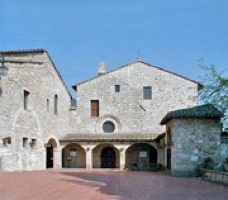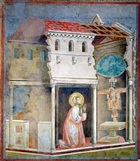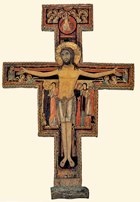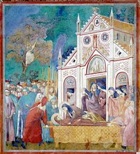


St Francis and San Damiano
In ca. 1205, the future St Francis of Assisi had a vision before a crucifix at San Damiano that started to shape his vocation. To his father’s dismay, he became an oblate (lay brother) here, and this unleashed a series of events that culminated in his renunciation of his inheritance in ca. 1207. St Francis then lived for about two years as a hermit under the protection of Bishop Guido I. During this period, he repaired a number of churches, including San Damiano and the Portiuncula. As we shall see below, the small church and its surrounding buildings soon became the home of the future St Clare of Assisi and a community of like-minded women who formed the nucleus of what became the Order of San Damiano.
St Francis never forgot the sisters at San Damiano, although he rarely visited them after 1212. However, in 1225, during the early stages of his final illness, he made what he probably expected to be a last short visit to them. However, his condition suddenly deteriorated, and he spent a few weeks in their care: it was here that he wrote the ‘Canticle to Brother Sun’.
St Francis and the Crucifix at San Damiano

After the death of St Clare, the sisters brought this precious image with them when they moved from San Damiano to Santa Chiara, and probably located it initially above the rood screen of the church. It was probably moved to the nearby church of San Giorgio in ca. 1260, the later site of the Cappella di San Giorgio at Santa Chiara. The original image is now in the arch of the bay nearest the altar wall of the chapel, but a copy of it still hangs in its original location in the apse of San Damiano.

-
✴St John the Evangelist, the Virgin and a tiny figure of Longinus are stand to the left of Christ:
-
✴St Mary Magdalene, Mary the mother of James, Longinus (now in full length after his conversion) and two tiny figures of Roman soldiers stand to the right; and
-
✴angels appear on the cross beam and also above the head of Christ, where they surround a tondo of the Ascension with the Hand of God above.
There were originally six small figures of saints at the foot of the Cross, although only SS Peter (with a cockerel over his head) and Paul are now visible.
Death of St Francis

St Clare and San Damiano
The future St Clare first heard St Francis preach (perhaps at San Rufino) in ca. 1210 and became one of his followers. Soon after, she secretly left home and joined him at the Portiuncula, where he lived with a small number of his (male) followers. St Francis received St Clare into the religious life by cutting her hair and giving her a rough habit to replace her fine clothes. Bishop Guido I agreed that St Clare and a few of her (female) followers (including her sister, St Agnes) might live at San Damiano.
St Clare and her Followers at San Damiano
Bishop Jacques de Vitry wrote in 1216 about the communities of ‘Fratres Minores et Sorores Minores’ (the Lesser Brothers and the Lesser Sisters) that he had come across during a visit to nearby Perugia. The women lived in hospices near the cities, ‘accepting nothing, living by the work of their hands’. This testimony suggests that the community at San Damiano was one of a number that formed in the area under the inspiration of St Francis.
The sisters at San Damiano initially adopted a simple ‘rule’ that St Francis wrote for them. However, the Fourth Lateran Council (1215) forbad new religious orders, and the form of life that Jacques de Vitry had witnessed would soon be impossible: under the new ruling, the sisters at San Damiano would have to accept a form of the Benedictine Rule, under which St Clare would be designated as the abbess of a cloistered community. Just before his death in Perugia in 1216, Pope Innocent III sugared the pill by issuing a Bull in which he declared that nobody could compel the community at San Damiano to accept property. St Clare was to spend the rest of her life fighting to keep this precious and unprecedented ‘privilege of poverty’. St Clare's vocation revolved around contemplative devotion to ‘the God Who was placed in a poor crib, lived poor in the world, and remained naked on the Cross’, (Testament of St Clare’, 45). Clausura did not directly threaten this central aspect of her new life, but it did make it more difficult to maintain contacts with the Franciscan brothers on whom she depended for spiritual and (now that the sisters could not solicit alms directly) for material support.
This problem was compounded by St Francis' increasing concern that the brothers should not be distracted by the growing number of female communities that professed a Franciscan vocation. Indeed, the first Visitor appointed for San Damiano in ca. 1218 was a Cistercian. While St Francis was away in the Egypt in 1219-20, Cardinal Ugolino (later Pope Gregory IX) appointed Brother Philip as Visitor to San Damiano. (Philip had been close to St Clare ever since her conversion, and the appointment might well have been at her request.) However, St Francis revoked the arrangement when he returned to Italy. However, as we have seen, he visited them shortly before he died.
St Clare's sense of isolation must have intensified after the death of St Francis . The Franciscans found it difficult and sometimes uncongenial to provide for the sisters, and they must often have gone hungry. However, she had the comfort of her family: her mother, the widowed Ortulana, her sister Beatrice and her aunt, Buona Guelfuccio (Sister Pacifica) joined her at San Damiano (at an unknown date). She also had the company of the other sisters at San Damiano; their accounts during the process of canonisation gives a palpable impression of the close and supportive community that she created.
Assisi, like the rest of Umbria, suffered during the war between Gregory IX and the Emperor Frederick II. The unprotected location of San Damiano made it particularly vulnerable, and a band of Saracens in the Imperial army attacked it in September 1240. The sisters were terrified, but the soldiers withdrew when St Clare appeared before them carrying the Eucharist. Danger returned in 1241, when Vitalis d Aversa laid siege to Assisi itself on behalf of the Emperor. However, a great storm dispersed the attackers in response to the prayers of St Clare and her sisters.
Order of San Damiano
As noted above, St Clare’s community at San Damiano was one of a number of female religious communities that formed in the early 13th century, often in response to the preaching of the Franciscans and other mendicant friars. In 1219, Cardinal Ugolino, a papal legate in Lombardy, Tuscany and Umbria, felt that many of them lacked appropriate spiritual and administrative guidance and therefore arranged for Pope Honorius III to place them all (including the community at San Damiano) under direct papal control. Soon after, he drew up a ’rule’ for them that was specifically designed to harmonise the practice of these ‘poor cloistered communities’, a term that implied that they were being ‘being corralled’ into a discrete religious order. There was nothing specifically Franciscan about this rule, and indeed (as noted above) the first Visitor that Cardinal Ugolino appointed for San Damiano was a Cistercian. However, he frequently recruited sisters from San Damiano for responsible positions in the other communities, a policy that ensured that elements of the Franciscan vocation survived within this ‘rule’. In 1228, a few months after he was elected as Pope Gregory IX, he appointed Cardinal Rinaldo dei Conti Segni (later Pope Alexander IV) as Cardinal Protector of both (male) Franciscan Order and the (female) Damianite communities.
Ugolino deeply respected St Clare and maintained an affectionate correspondence with her both before and after his elevation to the papacy. He therefore agreed to confirm the privilege of poverty for San Damiano in 1228. He also (very reluctantly and under pressure from St Clare) granted a similar privilege to a few of the other ‘Damianite’ communities, including that of Agnes of Prague in 1238. However, these were exceptions, and he more usually went to great lengths to ensure the endowment of the Damianite communities, particularly since the Franciscans were increasingly reluctant to do provide for them. He sometimes insisted that they should accept gifts that they wanted to turn away, and he sometimes arranged endowments himself.
The Order of San Damiano became officially Franciscan in 1247, when Pope Innocent IV imposed a new form of life that transferred the duty of care from the Cardinal Protector to the Franciscan Minister General. While St Clare must have relished this formal link to the Franciscan Order, she was greatly pained by another aspect of the new form of life: it explicitly allowed the communities to have properties and revenues. In addition, the transfer of responsibility to the Franciscans was hard to enforce while the Pope was in exile in Lyons and, from ca. 1250, Cardinal Rinaldo re-emerged as Cardinal Protector of the Order. Tired of all this, in ca. 1252, St Clare wrote her own ‘Way of Life for the Order of Poor Sisters established by St Francis’. Cardinal Rinaldo immediately approved it, but St Clare pressed for formal papal approval. She received the Bull conferring this approval on 9th August 1253, and died with it in her hands two days later. (The original rule was discovered in 1893 in a mantle that had belonged to St Clare: both are preserved at Santa Chiara.) St Clare's rule applied only to her own community: by securing it, she had, in effect. withdrawn her sisters from the Order of San Damiano.
Death and Canonisation of St Clare
In August 1253, it became clear that St Clare was dying. Innocent IV visited her at least twice during her final illness. Brothers Leo, Angelo and Juniper (all of whom had been among St Francis' early followers) attended her death bed, and St Agnes returned to San Damiano from Florence. Another of the sisters (Benvenuta) had a vision in which the Virgin and other virgin saints appeared around the dying St Clare, as if welcoming her into Heaven.
When St Clare died, the Podestà of Assisi placed an armed guard on San Damiano to protect her body from ‘relic seekers’. Innocent IV and the Curia arrived for the funeral on the following day. Innocent IV wanted to canonise St Clare on the spot by reciting the Mass for a Holy Virgin, but Cardinal Rinaldo objected that a proper canonisation process was needed. Innocent IV therefore celebrated the traditional Office for the Dead before leading the procession in which St Clares body was carried from San Damiano to San Giorgio.
Innocent IV appointed Bishop Bartolomeo of Spoleto to conduct the process for the canonisation of St Clare in October 1253. He died before the process was complete, and Cardinal Rinaldo, now Pope Alexander IV, duly canonised her at Anagni in 1255. In 1260, the Bishops of Perugia, Spoleto and Assisi translated the relics of St Clare from San Giorgio to a burial vault under the high altar of the sisters’ new church of Santa Chiara.

